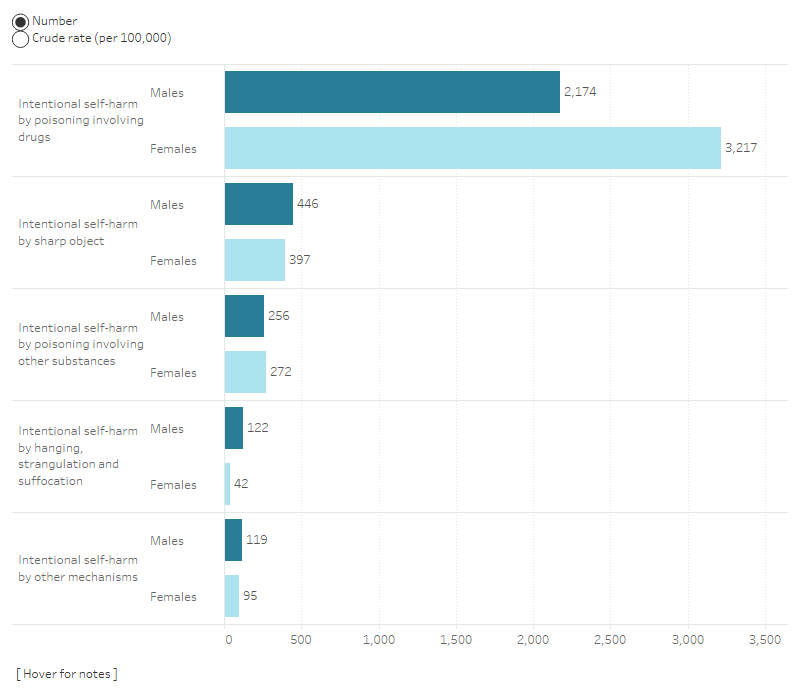Intentional self-harm
The data show that alcohol plays a key role in hospitalisations due to the two intentional causes of injury – intentional self-harm and assault. This section explores intentional self-harm in more detail.
For urgent crisis help call Lifeline on 13 11 14 or if life is in immediate danger call 000 If at any point you feel worried about harming yourself while viewing the information on this website—or if you think someone else may be in danger—please stop reading and seek help.
Alcohol and other drug use is associated with increased risk of suicide and is a strong predictor of suicidal thoughts and behaviours (Fisher et al. 2020).
There were over 7,100 alcohol-related injury hospitalisations due to intentional self-harm, 24% of all intentional self-harm hospitalisations in 2019–20.
In over 5,900 (83%) of the 7,100 cases, poisoning was the most common mechanism of intentional self-harm, followed by self-harm with a sharp object (840 cases; 12%) (Table 4 and Figure 6).
Of the 5,900 poisoning cases, 97% (5,760) were due to drug exposure, including alcohol, and 2.7% (160) were for exposure to other types of substances such as gases and vapours and pesticides (Table 4).
|
Mechanism of intentional self-harm |
Number |
Rate |
|---|---|---|
|
Poisoning (X60–X69) |
5,923 |
23.3 |
|
Drugs (X60–X64) |
5,394 |
21.2 |
|
Other substances (X65–69) |
529 |
2.1 |
|
Sharp object (X78) |
843 |
3.3 |
|
Hanging, strangulation and suffocation (X70) |
164 |
0.6 |
|
Other mechanisms (X71–77, X79–84) |
214 |
0.8 |
|
Total |
7,144 |
28.0 |
Note: Codes in brackets refer to the ICD-10-AM (11th edition) external cause codes (ACCD 2019).
Source: AIHW National Hospital Morbidity Database.
Figure 6: Top mechanism of self-harm used in alcohol-related injury hospitalisations, by sex, 2019–20
Bar graph showing that for intentional self-harm alcohol-related injury hospitalisations, poisoning involving drugs and intentional self-harm by sharp objects were the most common mechanism.

Intentional self-poisoning with drugs
Table 5 shows the types of drugs deemed to have contributed the most to the intentional self-harm injury hospitalisation (the first-listed external cause in the record). In 6.2% (370) of these cases, alcohol was the drug deemed to have been the primary cause of the hospitalisation and may have been the only drug involved. In 94% (5,560) of the cases, alcohol was a secondary contributing cause, with another drug or substance listed as the main external cause. Box 8 below describes how ICD-10-AM drug codes in the medical record were used.
Box 8: External cause codes and additional diagnosis
The presence of other drugs section outlines the drug groupings used in this report based on diagnosis codes listed in the patient’s medical record.
This section uses the external cause codes for intentional self-harm (X60–X84). The terminology used in the ICD-10-AM external cause codes is similar to that used for diagnoses. Tables A11–13 in the supplementary data tables presents the relevant intentional self-harm external cause codes and the additional diagnosis codes.
The most common category of drugs used in intentional self-poisoning was antiepileptic, sedative-hypnotic, anti-parkinsonism and psychotropic drugs (depressants) (3,300 cases). This drug category includes barbiturates and benzodiazepines (types of sedatives and hypnotics) commonly used to treat sleep disorders or anxiety.
The next most common drug category was Non-opioid analgesics, anti-pyretics and anti-rheumatics (1,050 cases), which includes over-the-counter drugs such as paracetamol, ibuprofen and aspirin.
Narcotics and hallucinogens (not elsewhere classified) which includes both prescribed and street forms of drugs such as cannabis, cocaine, codeine, heroin, LSD, methadone and morphine contributed 420 cases to intentional self-harm poisoning (Table 5).
|
Mechanism of intentional self-poisoning |
Males number |
Males rates |
Females number |
Females rates |
Persons number |
Persons rate |
|---|---|---|---|---|---|---|
|
Anti-epileptic, sedative-hypnotic, anti-parkinsonism and psychotropic drugs, not elsewhere classified (X61) |
1,360 |
10.7 |
1,926 |
15.0 |
3,286 |
12.9 |
|
Non-opioid analgesics, anti-pyretics and anti-rheumatics (X60) |
342 |
2.7 |
692 |
5.4 |
1,035 |
4.1 |
|
Narcotics and psychodysleptics [hallucinogens], not elsewhere classified (X62) |
203 |
1.6 |
215 |
1.7 |
419 |
1.6 |
|
Alcohol (X65) |
158 |
1.2 |
209 |
1.6 |
368 |
1.4 |
|
Other drugs acting on the autonomic nervous system (X63) |
51 |
0.4 |
92 |
0.7 |
143 |
0.6 |
|
Other and unspecified drugs, medicaments and biological substances (X64, X66–X69) |
316 |
2.5 |
355 |
2.7 |
672 |
2.7 |
|
Total |
2,430 |
19 |
3,489 |
27 |
5,923 |
23 |
Notes:
1. Rates are age-standardised per 100,000 population.
2. Codes in brackets refer to the ICD-10-AM (11th edition) external cause codes (ACCD 2019).
Source: AIHW National Hospital Morbidity Database.
For more detailed data, see Data tables A11–13.


